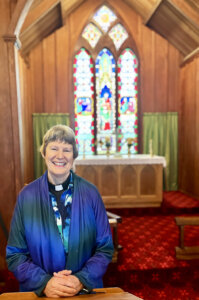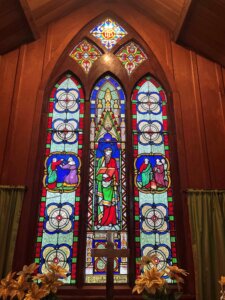
Reverend Julie Guest at St Paul’s Church on Rangiaowhia Rd in front of the stained-glass window which needs to be refurbished.
Historic windows into the past at both of the Waikato’s only two category one historic buildings – part of Te Awamutu St John’s Anglican Parish – need an upgrade projected to cost nearly $150,000.
The call has gone out for the community’s help as the parish seeks to make the work a reality and preserve “rapidly deteriorating” community taonga.
Te Awamutu St John’s Anglican parish priest Reverend Julie Guest said unique stained-glass windows at both Te Awamutu’s Old St John’s Church and St Paul’s Church on Rangiaowhia Rd are “getting worse by the month”.
At both churches, work required includes repairing cracks in the enamel of the window itself, and fixing the wooden arch in which the window sits.
One obstacle faced though, she said, is that while there are organisations which fund work on historic buildings, many won’t fund active churches – which both Old St John’s Church and St Paul’s Church are.
Category one historic places are places of special, or outstanding, historical or cultural significance.
Waikato’s only other category one structure is Cambridge’s Victoria Bridge.
According to parish records, Old St John’s – completed in 1854 – is thought to be one of, if not the, oldest church in New Zealand which has continually been used for worship since.
Aside from briefly closing for maintenance at one stage, and being shut during the Covid lockdown, the church’s doors have otherwise been open almost 170 years.
St Paul’s on Rangiaowhia Road opened two years later in 1856. Services are held there three times each month. A fundraising committee has been established to look at ways to raise the money to conserve, or refurbish, the windows.
When quotes for the work were last sought a year ago, estimates were that the St Paul’s window would cost about $60,000, the Old St John’s window about $40,000.
Reverend Guest said given the time that’s elapsed since then, costs are likely to have increased. She said the window at St Paul’s was last conserved, or refurbished, about 30 years ago.
“We’re essentially faced with a choice. We either do nothing, in which case they’ll get worse – or we act now.
“We are stewards of this incredibly special taonga, and we have a responsibility to take that role seriously. I really sense that. “My major concern is that we do what we can to make sure this part of our history can still be told here for generations to come.”
Reverend Guest said earlier this year, the St Paul’s congregation had helped ensure the exterior of the church was repainted at a cost of $60,000.

The stained-glass window at St Paul’s Church.
At the same time, a new $11,000 cross was made for the top of the church.
“These buildings tell the stories of our history – they’re places which gather people and, prayerfully, help heal our community.”
She said Māori records show about 4000 people were living at Rangiaowhia when St Paul’s was built.
It was a wheat growing area, flour was being sent to Auckland, then on as far afield as Australia and California.
Worship at St Paul’s came to an abrupt end when the Rangiaowhia attack drove the surviving Ngāti Apakura and Ngāti Hinetu people away from their settlement.
The church lay empty for about 10 years, until repair work began in the 1870s.
As well as St Paul’s at Rangiaowhia and Old St John’s Church and St John’s Church on the same site in Te Awamutu, Pirongia’s St Saviours Church is also part of the parish.
In April, The News revealed there were plans to resurrect Rangioawhia as a world heritage site.









